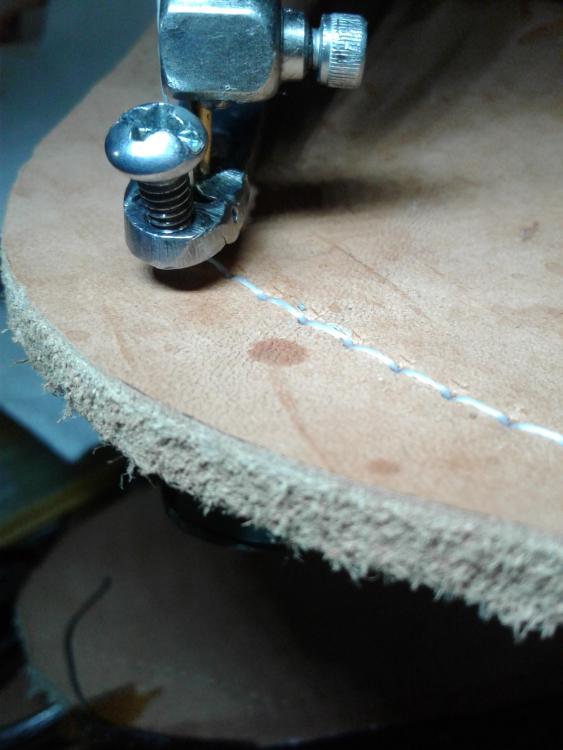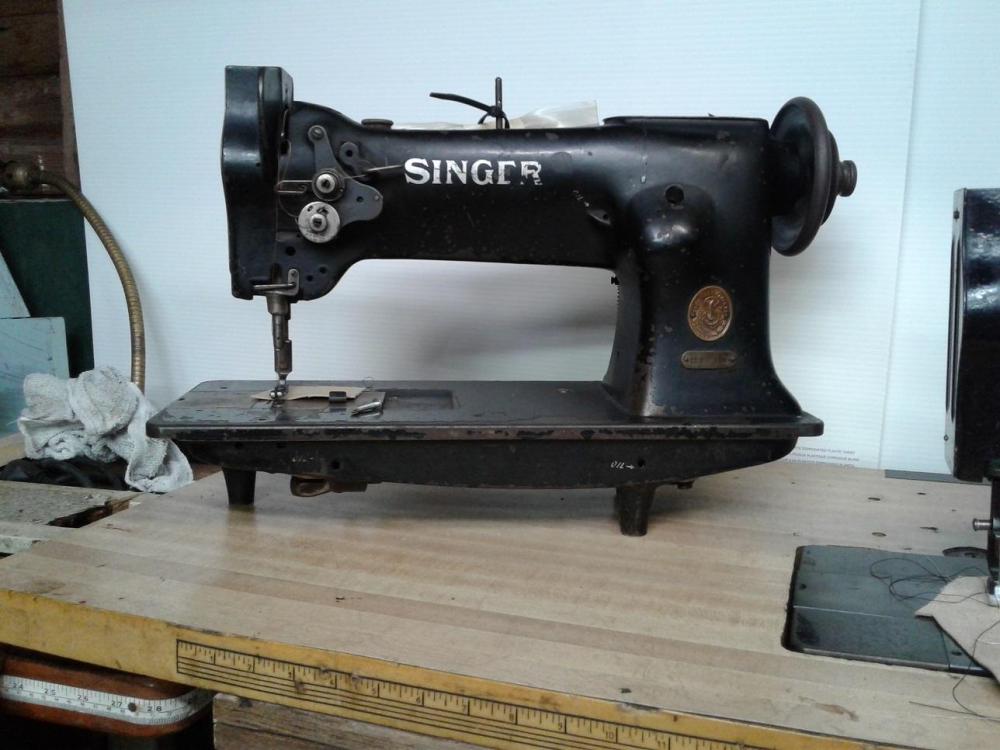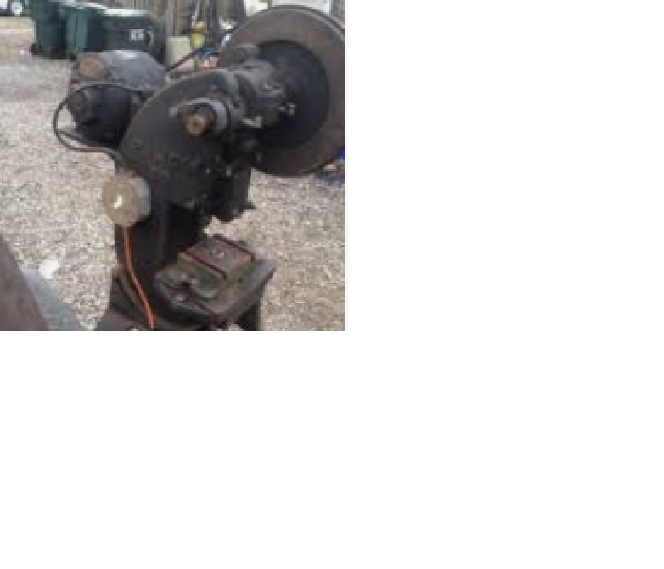
ljk
Contributing Member-
Posts
201 -
Joined
-
Last visited
Content Type
Profiles
Forums
Events
Blogs
Gallery
Everything posted by ljk
-
Adler 30-1 treadle long arm patcher purchase questions
ljk replied to chiefjason's topic in Leather Sewing Machines
I tried to download a video but it was giving me chest pains so I did a picture. I will cover a few issues. I believe most patchers load (pierce) at the same point regardless of stitch length. Therefore once you adjust the piercing point to match the needle your good to go. If you will notice the pierce is is along side the needle hole. that can be adjusted by moving the foot side to side slightly or rotating the screw slightly. I usually use a set screw vs the shown screw. The screw shown can interfere with the needle bar in some rotational places. The teflon on the throat plate is simply rough sanded cleaned with acetate and glued on. I use Seal All contact cement good stuff. This goes back 25 years ago when we had a fad going at mc shows with unlined mc vests and I was having feeding problems doing pockets, that 29-4 still has that teflon on the plate. Early Machines 29-4 and 30-1 feet may need to raised a little by grinding the foot.. Later model Adler or Singer will work well with this mod, as will the chinese varieties. The ultimate would be a Claes Model 30 (1/4 stitch length 1/2 lift) The handcrank chinese shoe patches is the easiest to modify because of high lift and long stitch capabilities. The ultimate conversion would be a tiny tool steel tube around the needle allowing good vision with a open foot. -
Adler 30-1 treadle long arm patcher purchase questions
ljk replied to chiefjason's topic in Leather Sewing Machines
-
Adler 30-1 treadle long arm patcher purchase questions
ljk replied to chiefjason's topic in Leather Sewing Machines
Made short file with foot stitching on 5mm leather with teflon on needle plate leaving no marking on leather. tx Lynn foot.wlmp -
Adler 30-1 treadle long arm patcher purchase questions
ljk replied to chiefjason's topic in Leather Sewing Machines
You guys just about covered it all again and again good for you and your patience. I've only had one low mileage model a singer 72. this one was in the shop. My road machine was a 30-1 set up with a xl belt reduction drive running a 1.5 amp motor. This setup came out of a sturdy box and was set on the lid and was ready to go. Here are my modifications mig the bell crank, made a special needle plate out of a thin pc, of metal and glued a 2mm pc teflon on it. I also took a foot and welded a nut on the end and ground the screw to a point so I could grab the material. the point matched the needle penetration therefore it didn't mark the leather. I have heavily polished the hook and shuttle to gain a little more clearance. These are a nice addition to the fleet but it is certainly not going to be your primary machine. -
Hello I've had dozens of these machines My first in 1976 brand new , still working in my old shop. I've had no issues except timing. These machines have clutches (a must), horizontal axis hook design these are far less subject to hook jamming than vertical axis machines. Hook is secured to a keyed shaft, timing much easier. just adjust needle bar. Best machine for rookies or the experienced. My choice the new one. I've had the chinese version and it sews well . Plus it will do a little more thickness. I also like the stitch dial and the reverse position.
-
I do a lot of sharpening both as a volunteer and in my trades. in your instance I would acquire two EZE-LAP diamond sharpeners, fine and medium. about $5-$8 each US. Take the scissors apart and clean the inside surface with oil and fine wet a dry sandpaper. your just cleaning nothing heavy. Now take a magic marker and coat the sharpening edge. Now using the EZE with water sharpen surface on each knife until marker edge is clean. You may only need fine edge if new. Now reassemble, should cut the paper to the point. Using this method I could cut 20 pair of motorcycle chaps before need to resharpen. Fabric unless Kevlar could last for weeks. I use 8" MDF with veg. on one wheel and and sharpening powder on the other. ( mix powder with a little Titebond 3 and apply with brush. Elmers will work. For most knife work I use 1"x30" homemade belt sander and finish with leather 8" wheel. Today I did 2 garden pruning shears with mini air powered belt sander, this gave a good edge with a little bite to grab the limb. I use 1725 rpm motors for wheels helps from burning tips. good luck Lynn
-
We have been using atv tape (double sided) for over 20 years. The gun (Scotch atv 700) allows for easy application ( about $25 on ebay). Originally found in picture framing. We started using it in the motorcycle patch business. We could use it to mount patches with no mess. It would hold with ease for stitching. In the winter we made leather products and used it for taping fringe, applying labels and any application that needs temporary attachment prior to sewing. Today we no longer have that business but still operate a online embroidery custom patch business and tape is indispensable for mounting paper backing to embroidery twill prior to embroidery. Buy the 3m stuff and refrigerate the extra until use. For stronger applications I use SEALALL contact cement from the Dollar Store, quick set up ( about a minute ) and very strong. Indispensable for my leather hobby. tx Lynn
-
One thing I don't seen mentioned is a obstruction under the bobbin case. The thread path of the needle (top thread) has to make that trip around the bobbin case. What can happen is fluff from sewing, thread jamming causing thread bits and pieces, will eventually cause a obstruction. Remove the jib and remove the bobbin case. Clean under and return the bobbin case. The small screws must not be lost. I have a coffee can full a old hooks and none of those screws seem to fit another. Thin thread like #46 or #69 make make the trip but #92 won't. Next issue is a properly adjusted thread release. Finally do the YouTube 111w155 howto videos.
-
You may want to consider a Merrow machine either a 2 or 3 thread machine. Some use Merrow floss. Very good machines with a steep learning curve. US made with good parts availability. May be able to help if you sent sample of fabric. tx Lynn
-
Please give your opinion on my sewing machine purchase
ljk replied to Louiesdad's topic in Leather Sewing Machines
I would consider the Singer 144w. They were available in short and long arm version 20" and 30". They have big bobbins,. high lift (1") and long stitches. I used a 12" version for years in my leather shop when my 206's reached capacity, we called it T-rex. Most long arm versions where used in factory settings thus heavy wear. Price for those run around $1500 with reverse about $2000. I have a source for a 144w305 a non factory machine in Colo. The Consew 206 was available in 20" arm I consider it equal to any euro machine especially the Seiko made versions. -
Consew 206-rb5 seems to snag, sort of, on the upstroke
ljk replied to wydfuqnopn's topic in Leather Sewing Machines
Step one Make sure top thread is threaded properly including take up spring. Step two Hook is close to the needle about 1/32. Hook is on keyway so don.t worry about losing timing. This is important cause the top thread may get split if not close enough. Step three Check that escapement is properly adjusted. I've had 206s since 1976 and have never had to adjust that item. Step four Check needle bar for proper height, check you tube I I don't remember the specs. If this doesn't work send pictures. -
I have two problems with glue in the shop in the house. One my wife complains about the smell and two I worry about the fumes. My solution is small tubes of contact cement (limited exposure) Seal All at the Dollar Store great stuff. 2oz for $2.99 (1-2 minute setup) I also use Elaines leather glue filled in a Grout Sealer Applicator Roller (Home Depot etc.) Modge Podge outdoor is good stuff and waterproof when it dries I use it on wallets it can be washed off surface. (can be a problem with contact cement.) Please note Seal All sets up fast the other needs to be clamped.
-
I do have a reliable clicker with a 20x40" bed. Small pcs. would run .50 to $1.00 for 100 to 500pcs. Can also do steel rule dies. Also have machines and know experienced sewers Amish In the valley I live in in southern colorado. The Amish are like anybody else their skills vary, However we are close friends with the local bishop and his wife and they could find a good sewer. tx Lynn
-
I have a 144w305 for sale in Colo. You may want to research this machine online. It has reverse and the feet lifting height is very easy to adjust. Will sew #69/#277 thread. This is not a factory machine. If interested let me know. Can't send video or pictures for 3weeks $1850 A new Juki (same design) is $10,000 These machines were built in Germany. 30" bed. tx Lynn
-
Once a year I have had a regular order requiring a 1/4" double needle. The rest of the time just a single needle. I set this up so I could use either machine. A spacer plate was used for the the single needle. I also needed precise speed control, so I add reduction on top which would fit both machines, also I could handwheel if needed. Also the regular belt would go to the clutch motor If I needed more speed. The double needle also has a 1/2 gauge set. This machine also has the needle lift bar for corners. Both machines and table $500. Would exchange single needle with a excellent 111w155 for total of $650. Going to Colo. end of May, would consider dropping off on the way. tx Lynn
-
I do have a power trip hammer at my Colo. home, but won't be there until June. It runs off a electric motor to a flywheel and has trip lever which can be foot or hand operated. It has a adjustable drop. It weighs about 300 lbs. I just picked it up in June 2018 and broke my femur July 2018 I Can't remember the mfg. I't was in wonderful condition with all the paint on it. If I can remember the name i will let you know. The attachment is very close Let me know if interested tx Lynn
-
I do have a simpson 489 auto feed approximate size
0 eyelet. Price $125 plus shipping. I'm in Fl. until may,
Then Colo.
-
I missed your post on the hook. The hook is on a keyed shaft with out any timing changes. Just release the screws on the hook slightly and realingn with needle bar. You may want to put in a needle. Also reset clutch if it is engaged
-
I consider this one of the best general purpose machines for upholstery and leatherwork. My first a new one in 1976 for $800 and still running in my old shop. My sister in law bought a new one the same year and didn't oil for 25yrs. My wife didn't want me to oil, because one drop would ruin a deerskin garment she was sewing. I've had all three over the years Japan, Taiwan,and China. The Japanese machine had the best finish both on paint and metal parts but they all work good. My 144 Singer and Nakajima 280L will sew thicker thread and thicker material but it is still my go to machine. With the 206rb I maxed out on my MC chaps at the belt with 7 layers @4oz and one at 6 or 7oz. That's when I bought a 144 singer we called it T Rex. to do more thickness.The 206 would sew thicker by raising the foot but made it hard to sew lining. Every used 206 I've bought had issues all could be repaired easily Remember if it's used there is a reason.
-
THIS MACHINE IS LISTED ON CRAIGSLIST DAYTONA BEACH UNDER INDUSTRIAL SEWING MACHINE. PROBABLY TO EXPENSIVE TO SHIP WITH TABLE, WHICH YOU COULD FIND IN NYC. $425 WITHOUT TABLE PLUS SHIPPING. THESE THINGS WERE USD TO DEATH, I HAVE A REALLY NICE ONE.. THIS IS THE MODEL WITH THE STITCH LENGTH ADJUSTMENT ON THE BED. YOU JUST PUSH THE BUTTON AND ROTATE.
-
I do have both manuals but could use help from forum members on a easy way to send to you images. Don't run till lubed. I suspect flywheel was changed for a reason. My machine had the flywheel machined and brake shoes replaced. I did add a second control for safety, since I had employees running machine. I use 30 wt. oil. USMC recommend something special else it's in the manual.
-
These are great machines once properly adjusted. However they have one problem they will double click or worse after a few hours of use. The internal clutch will grab the flywheel and the external brake will not be able to stop the engagement. This is a small issue once you are used to the machine you either back off the clutch or increase the brake pressure. The were designed for cutting shoe soles at a rate of 600 pairs a day.
-
I bought one off these machines because my Adler or Singer patchers didn't have enough lift or stitch length to put pulls on the boots I make. It has adjustment for needle bar and hook. The cams are bearings vs plain and the main shaft has ball bearings. Because of adjustable needle bar I use 135x17 needles. It has a longer stitch than most shoe patchers and it has a 1/2 lift. The bobbin winder is crap and the bobbin and hook need polishing. It handles 92 bobbins and 138 needle thread. I put a Teflon pad on the throat plate. There is a video on youtube Wolf Moehrle who will make most of you jealous with this machine. His wallets are very well done.
-
This is commonly called a line shaft clutch. Put a 1 1/2" pulley on that motor with 1725 rpm and you will have a ideal upholstery setup. I also used this on the bike circuit especially in rural areas like Sturgis because you could buy a motor at the farm store but not a servo or clutch motor. However a servo motor is the best choice. So if you have control problems buy one of those. If you want to make money go as fast as you can handle the machine.






